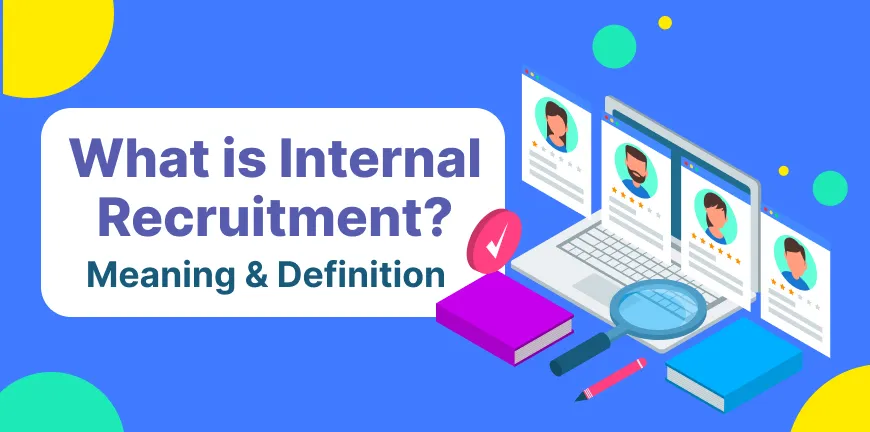
Digital Credentialing: Speeding Up Compliance in Healthcare Hiring
13/10/2025
26+ Biggest Interview Mistakes (To Avoid in 2026)
13/10/2025- What is Internal Recruitment?
- What are the types of Internal Hiring?
- Why Do Companies Use Internal Hiring?
- What are the Advantages of Internal Hiring?
- What are the Disadvantages and Limitations of Internal Hiring?
- What is the Internal Recruitment Process?
- Key Differences Between Internal and External Recruitment
- Conclusion
- Frequently Asked Questions (FAQs)
Given the shortage of talent in the business landscape, internal recruitment could prove to be a smart strategy for ensuring a strong talent pipeline. According to a LinkedIn global talent trends report, approximately 41% of employees tend to work for longer periods in organizations that prioritize hiring and promoting from within.
In recent times, given the competition for talent out there, businesses have come to understand the benefits of hiring from within the organization. By offering them proper training to build their skills internally, employers can eliminate the need for hiring from outside. Also, it makes sense to make use of the rich knowledge and expertise that the existing employees have gained over time in the company. This helps improve employee retention and boosts the morale of employees.
What is Internal Recruitment?
Internal recruitment refers to the process of hiring from within the organization to fill open job roles. What does this mean? Potential existing employees with a bit of training are hired for open positions, or current, high-performing employees are promoted to a higher position that is currently vacant, instead of recruiting from outside the organization.
What are the types of Internal Hiring?
There are several types of internal recruitment. Some of the examples of internal hiring include-
1. Succession planning
This involves identifying and training current employees in the organization to fill crucial higher positions in the company. With the right training, these individuals easily transition to leadership roles.
2. Role changes
This is where an employee with the required skills is shifted to another role that needs to be filled immediately within the organization. This could involve changes in job responsibilities, but without the formal acknowledgement of a transfer or promotion.
3. Transfers
An employee is relocated or transferred to a different department or even a different work outlet within the organization.
4. Promotions
As the name suggests, a current high-performing, potential employee is promoted to a higher leadership position, usually with increased pay as well as important responsibilities.
5. Internal mobility programs
Internal mobility refers to moving within the organization. These programs allow employees to explore opportunities from within the organization and allow them to be a part of short-term assignments, project-based work, or rotational programs.
6. Cross-training
Cross-training involves training employees to equip them with skills that aren’t required in the current job role but are needed for another or a future, potential job. This helps expand their horizon and encourages them to view a wider range of roles within the company.
7. Skills assessment
Here, employees’ skills are evaluated, and training programs are developed to upskill them or increase their capabilities. It helps bridge the skills gap for existing and future roles.
Why Do Companies Use Internal Hiring?
Internal Recruitment method is the one to go for when organizations are pressed for time and are looking to hire and fill positions quickly. Companies use internal recruitment methods in the following scenarios.
1. Looking to hire swiftly
When an organization is looking to fill the open positions in its organization quickly, without delay, internal hiring is perfect. In internal recruitment, you don’t have to do the headhunting part and go through the traditional recruitment process; instead, recruit from within, conducting a shorter interview process and leaving out the background check process, as they are already employed within your organisation.
2. Have a tight budget
When companies are working on a tight budget, this form of hiring works. By hiring from within your organisation, you can reduce the costs spent on the recruitment process, which could include paying for job boards to post your job opening and paying media companies for post listings. You can instead share your requirement through company emails and newsletters.
3. Require highly engaged employees
When employees are hired internally, companies can expect them to perform better and be better engaged. Why? Because you are interacting with employees who understand your company culture and are already doing well in their roles. By promoting these employees, not only will you be showing your commitment towards them, but it will also lead to higher engagement.
4. Reduce performance risks
Hiring from within the company allows you to access all the information about the candidates. You can review the candidate’s performance so far and even have a word with their co-workers to gain better insight into their nature and fit for the role. This ensures reduced risk of bad performance.
What are the Advantages of Internal Hiring?
1. Cost-effective
By hiring or moving employees internally into other roles, companies can reduce costs. What are these costs? Those that are spent on advertising job positions, background checks, and other hiring processes.
2. Faster hiring
This is an easy one to guess. You are basically hiring employees who are already working in your organization. So, it’s not just quick, but so much easier as it doesn’t involve the lengthy recruitment process.
3. Improved employee morale
When you encourage your current employees to learn more skills because you have the confidence to promote them to higher positions or transfer them to in-demand positions, it boosts their morale. They tend to show more commitment.
4. Less training time
Since your current employees already understand your work culture and processes, training them could take up fewer resources and time.
5. Lower risk
Hiring from within reduces the risk of bad performance or underperformance because these employees are already working in the organization and have obviously not disappointed you with their work quality.
6. Talent retention
When employees are encouraged to take other positions in the organization, the retention rates automatically go up.
7. Informed decision-making
You already have enough information on your current employees that you are planning to hire for another role. Information like work history, performance history, and more can help them make better decisions.
What are the Disadvantages and Limitations of Internal Hiring?
1. Limited pool of candidates
By hiring internally, potential candidate prospects are reduced, as you have to hire from existing employees. This may lead to missing out on better or diverse talent.
2. Lack of fresh perspectives
Hiring from within means you only get opinions and ideas of employees whom you already know and have an idea of their working style, leading to a lack of fresh perspectives.
3. Employees become complacent
When existing employees know they are about to be hired for a better position, they may become complacent, relying on their new promotion or transfer rather than upskilling themselves.
4. Risk of favouritism
Hiring internally could sometimes lead to hiring the wrong individuals or the best individuals due to politics in the office, favoritism, or unconscious biases.
5. Negotiation leverage is limited
Employees who are already working for you may not have enough points to negotiate better compensation or better benefits, as they are already pre-assessed. This could lead to issues with being compensated fairly.
6. Stifles external hiring
When you start focusing only on hiring internally, potential candidates may stop applying, leading to fewer, fresher prospects.
7. Unfulfilled skill requirements
You may be able to train your existing candidates to equip them with the required skills to take up other positions, but the skill gap may not be completely filled.
What is the Internal Recruitment Process?
- Make sure that the job openings in your organization are clearly put out there for everyone interested in them. Use job boards, emails, and newsletters.
- Your recruitment process must be transparent, meaning you must mention all the job role details clearly. This includes selection criteria, skills required, and more.
- Be fair while selecting candidates for the new job position. They must be chosen based on their performance and skills, and not on other biased criteria.
- The employees you choose must be given fair training opportunities to learn the skills that you want them to have. Give them the time to adjust to the new role.
- To avoid chaos or dissatisfaction, make sure to provide employees who are not selected for the positions with proper constructive feedback.
- Make sure to keep an eye out for your existing workforce constantly to identify candidates who may be good to take up future positions.
- Encourage employees who do not have the skills required for the role and are from other departments to apply for the job and learn these new skills. It can lead to more well-rounded employees.
- Your recruitment process must be inclusive. Everyone must get the opportunity to apply for it, no matter their current department.
Key Differences Between Internal and External Recruitment
Internal and external recruitment differ in their source of candidates, hiring speed, cost, and overall scope. The table below highlights the key distinctions to help organizations choose the most suitable hiring approach.
| Internal Recruitment | External Recruitment | |
| Source | Employees from within the organization are recruited and transferred, or promoted to new open positions | Employees are recruited from outside the organization through headhunting. |
| Induction | Employees do not need induction training as they are existing employees and are well-versed with the operations | Induction training is required as they are new, fresh employees who are recruited from outside the organization. |
| Speed of recruitment | Recruitment is much faster as it happens from within, and employees are already employed within the firm. | It is slower as it involves all recruitment stages like advertising, screening, selection, training, and induction. |
| Basis | Employees are recruited based on merit cum seniority level | Employees are recruited based on their skills as well as their qualifications |
| Cost | It is a cost-effective process as there is no need to spend on advertising and other aspects of recruiting externally | A significant amount of money is spent on advertising, background checks, and more. |
| Scope | The scope to recruit fresh talent is limited, as the selection happens from within the organization | The scope of recruiting skilled, fresh talent is higher as outside candidates are recruited. |
Conclusion
Internal Recruitment could be exactly what organizations need in these tough times, where the talent competition is so high. Not only does internal recruitment help hire potential candidates quickly, but it also reduces the need for extensive training and ensures a skilled individual for the open position. It is a process that is so much more hassle-free while also being extremely effective. Internal recruitment could be exactly what companies need, especially if they are pressed for time but still want a skilled, reliable candidate to fill a crucial position.
Frequently Asked Questions (FAQs)
1. What is Internal Recruitment in HR?
Internal Recruitment in HR is the process of hiring employees from within the organization by transferring them or promoting them to fill open job positions.
2. What are the different types of internal hiring?
Some of the different types of internal hiring include promotion, transfers, succession planning, role changes, internal job postings, internal mobility programs, and more.
3. What are the benefits of internal recruitment for companies?
The time to hire is reduced, there are shorter onboarding times, higher chances of better employee engagement, lower chances of lower productivity, and it costs a lot less.
4. What are the disadvantages of internal hiring?
With internal hiring, companies may lose out on fresh perspectives, a wider talent pool, skilled candidates, and the chance to hire from diverse backgrounds. It can also lead to internal employees becoming complacent.
5. What is the difference between internal hiring and external hiring?
Internal hiring refers to recruiting employees from within the organization to fill open positions. External hiring is when you hire from outside the organization, with applications coming in from prospective candidates outside of your organization looking to work in that role.
6. What is internal mobility in recruitment?
Internal mobility is the strategic movement of current employees into new roles, departments, or locations within the same company, rather than hiring externally.
Contact Us For Business Enquiry

Amit Saproo
Amit Saproo is the Head of Operations at ALP Consulting with nearly 17 years of experience in Executive Search, RPO, Leadership, and IT & Engineering recruitment. He leads nationwide recruitment programs across Technology, BFSI, and R&D domains, driving strategic hiring solutions for diverse client needs. Amit excels in building and managing high-performance teams that deliver scalable, end-to-end recruitment and consulting services.




